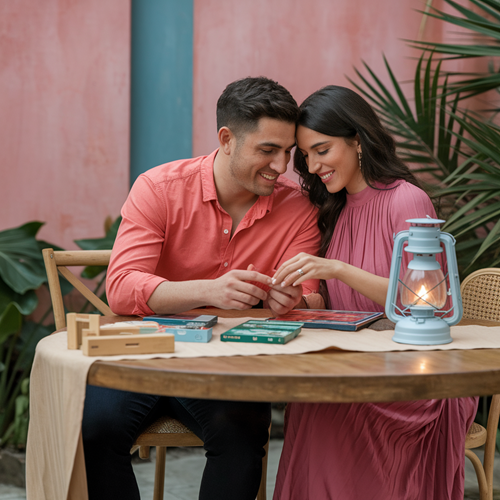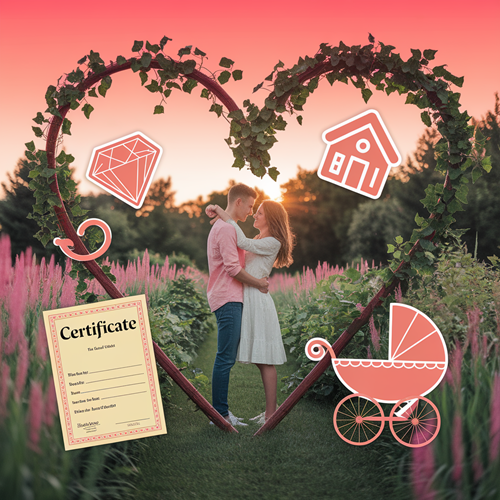In a world where distractions are endless and time feels fleeting, cultivating lasting relationships might seem like an elusive goal. Yet, thriving partnerships aren’t built on chance—they’re nurtured through intentional habits that prioritize connection, growth, and mutual respect. Welcome to Everlasting Bonds , your ultimate guide to not just maintaining but elevating your relationship into something extraordinary. This isn’t about quick fixes or outdated advice; it’s about modern, science-backed strategies tailored for today’s fast-paced world.

Imagine transforming everyday moments into opportunities for deeper intimacy or using technology—not as a barrier—but as a tool to strengthen your bond. Picture yourself navigating conflicts with ease, turning disagreements into stepping stones for growth rather than division. These aren’t pipe dreams; they’re achievable realities when you adopt the right habits.
Take micro-moments of connection , for example—a concept rooted in neuroscience. A simple act like holding hands during a walk or sharing a warm glance across the room triggers oxytocin release, often called the “love hormone.” It fosters trust and closeness without requiring hours of effort. Apps like Happify can help couples practice gratitude together, reinforcing these micro-moments digitally while keeping them fun and engaging.
Or consider how setting digital boundaries can reignite connection. With tools like FocusMate or Forest , couples can gamify unplugging from devices during meals or date nights, ensuring quality time remains uninterrupted. Imagine swapping screen time for meaningful conversations or rediscovering hobbies you both enjoy—like cooking a new recipe or planting a garden. Brands like Click & Grow offer smart indoor gardens perfect for co-creating projects that nurture both plants and your partnership.
Even physical touch goes beyond romance. Studies show non-sexual gestures like hugging or giving back rubs reduce stress hormones and increase feelings of safety. Incorporate touch mapping into your routine by creating a chart of different types of affection (e.g., hugs, massages) and rotating weekly. Pair this with synchronized breathing exercises to activate the vagus nerve, enhancing relaxation and emotional intimacy.
Finally, embrace emotional agility —a term popularized by psychologist Dr. Susan David—to navigate conflicts compassionately. When tensions rise, use techniques like the “Pause-and-Reframe” method: pause for 60 seconds before responding, reframing thoughts to focus on understanding your partner’s needs instead of assigning blame.
These habits blend cutting-edge psychology, real-world applicability, and innovative tools to address modern challenges head-on. Together, they form a holistic framework for building resilience, joy, and enduring love.
Because thriving relationships don’t happen by accident—they’re cultivated through deliberate actions. Start small, stay consistent, and watch your bond flourish.

You’ve heard about the importance of quality time—but what if the real secret to lasting intimacy lies in something far simpler? Enter micro-moments , those fleeting, seemingly insignificant interactions that hold immense power in strengthening emotional bonds. Research shows that small, consistent gestures—like a warm glance across the room, holding hands during a walk, or simply saying “I see you”—can deepen intimacy over time. These moments trigger the release of oxytocin, often called the “love hormone,” which fosters trust, closeness, and a sense of belonging.
The beauty of micro-moments is their simplicity and accessibility. You don’t need hours of uninterrupted time or elaborate date nights to nurture your relationship. Instead, it’s about being fully present in the little things. For example, imagine how a single meaningful look can remind your partner they’re valued—or how holding hands while running errands can make an ordinary day feel extraordinary. These tiny acts may seem minor, but their cumulative impact is profound.
Actionable Tip: Start practicing daily gratitude glances —a powerful yet effortless way to connect. Take 30 seconds each day to look your partner in the eye and silently acknowledge one thing you appreciate about them. It could be as simple as admiring their resilience, humor, or thoughtfulness. This practice not only reinforces positivity but also rewires your brain to focus on what’s working in your relationship rather than what’s lacking.
For added depth, pair this with a nightly ritual of sharing one positive moment from your day . Apps like Happify or Gratitude Journal by Happy Tapper can help guide these conversations, offering prompts and exercises to keep the habit engaging. Studies show that couples who regularly express gratitude and reflect on positive experiences report higher levels of satisfaction and connection. Over time, these rituals become second nature, creating a foundation of appreciation and understanding.
Why does this matter? In today’s fast-paced world, where distractions abound and attention spans are short, micro-moments offer a lifeline to deeper intimacy. They remind us to slow down and savor the present, even amidst chaos. Imagine transforming everyday routines—a shared meal, a morning coffee, or a quiet evening at home—into opportunities for connection. These moments aren’t just fleeting; they’re investments in your relationship’s future.
By prioritizing micro-moments, you’re not just maintaining your bond—you’re actively enriching it. Each glance, touch, and word becomes a thread woven into the fabric of your love story, making it stronger and more resilient.
In the end, love isn’t about grand declarations—it’s about showing up consistently in ways that matter most. And sometimes, the smallest moments leave the biggest imprint.
Technology has transformed the way we connect—but it can also quietly erode our relationships if left unchecked. Constant notifications, endless social media scrolling, and work emails creeping into personal time create emotional distance between partners. The result? Moments that could have been spent deepening your bond are instead fragmented by distractions. But here’s the good news: with intentional effort, technology doesn’t have to be a barrier—it can become a tool to strengthen your connection.

The first step is setting clear digital boundaries as a team . Start small by designating tech-free zones in your home, such as the bedroom or dining table. These spaces should be reserved for uninterrupted conversations and quality time together. You can also implement “no-phone hours” during meals or meaningful conversations. By agreeing on these rules together, you’re not just protecting your relationship—you’re prioritizing each other.
For couples looking to make unplugging fun and rewarding, try apps like FocusMate or Forest , which gamify the process of staying off devices. For example, FocusMate pairs accountability partners (hint: your significant other!) to stay focused on tasks without distractions, fostering teamwork and mutual support. Similarly, Forest lets you grow virtual trees together whenever you resist the urge to check your phone. If either partner picks up their device, the tree dies—a playful yet powerful reminder of your commitment to being present. These tools turn unplugging into a shared challenge, making it easier to stick to your goals.
To take things further, introduce a weekly Tech-Free Date Night . Swap screens for analog activities like playing board games, cooking a new recipe, or stargazing under the night sky. Apps like SkyView Lite can enhance stargazing by identifying constellations—without stealing attention away from each other. Bonus points if you document these moments in a shared photo album or journal. Over time, this becomes a cherished keepsake that reminds you both of the joy found in truly being present.
Why does this matter? Studies show that excessive screen time increases stress and reduces emotional intimacy. By creating space to unplug, you’re giving your relationship room to breathe and thrive. Imagine replacing mindless scrolling with laughter over a homemade dinner or heartfelt conversations about dreams and fears. These moments aren’t just fleeting—they’re investments in your future together.
Thriving relationships require intentionality, especially in a hyperconnected world. By setting digital boundaries and embracing unplugged moments, you’re choosing to prioritize what truly matters: each other.
With these strategies, you’re not just unplugging—you’re reconnecting in ways that deepen your bond and reignite your love. After all, presence is the greatest gift you can give your partner.

Shared experiences are the glue that holds relationships together—but why limit them to vacations or dinners? Modern couples are discovering the transformative power of co-creation rituals , where they collaborate on meaningful projects that deepen their connection. Whether it’s planting a garden, starting a passion project, or creating vision boards for your future, these shared endeavors foster teamwork, ignite creativity, and build a sense of accomplishment that strengthens your partnership.
Imagine working side by side with your partner to nurture something that grows—literally or metaphorically. For example, brands like Click & Grow offer smart indoor gardens that make co-creating life simple and rewarding. With minimal effort, you can grow herbs, vegetables, or flowers right in your home. The process of planting, tending, and harvesting becomes a shared journey—a metaphor for nurturing your relationship. Watching seedlings sprout into thriving plants mirrors how care and attention help love flourish over time.
For those who prefer creative projects, consider designing a vision board together. Use tools like Canva (a free online design platform) to digitally craft a visual representation of your shared goals, dreams, and aspirations. Print it out and display it in your home as a daily reminder of what you’re building together. This exercise not only aligns your visions for the future but also sparks deep conversations about what truly matters to both of you.
Unique Twist: Launch a “relationship journal” to document your journey together. Each week, take turns writing entries about your dreams, fears, or reflections on your relationship. Over time, this journal becomes a cherished keepsake—a tangible record of your growth as individuals and as a couple. For extra flair, include mementos like photos, ticket stubs from date nights, or handwritten notes from special moments. Products like Leuchtturm1917 notebooks or Moleskine journals offer high-quality options perfect for this purpose, turning your journal into a living scrapbook of your love story.
Why does co-creation work so well? Science shows that collaborative activities release oxytocin, the “bonding hormone,” which enhances feelings of closeness and trust. By investing time in shared projects, you’re not just strengthening your bond—you’re creating lasting memories that become the foundation of your relationship.
In today’s fast-paced world, co-creation rituals provide an antidote to distraction. They remind us to slow down, focus on each other, and celebrate the beauty of working together toward something meaningful.
So whether it’s tending to a smart garden, crafting a vision board, or filling pages of a relationship journal, these rituals transform ordinary moments into extraordinary connections.
With co-creation rituals, you’re not just spending time together—you’re building a legacy of love, one shared project at a time.
Conflict is inevitable in any relationship—but it doesn’t have to be destructive. In fact, when handled with care, disagreements can become powerful opportunities for growth and deeper understanding. Enter emotional agility , a groundbreaking concept pioneered by psychologist Dr. Susan David. Emotional agility teaches us to approach conflicts not as battles to win but as moments to learn, connect, and strengthen our bond. Instead of avoiding tough conversations or reacting impulsively, emotionally agile couples navigate conflict with curiosity and compassion. They listen deeply, validate each other’s feelings, and focus on solutions rather than blame.

The secret lies in shifting your mindset during heated moments. A game-changing exercise is the “Pause-and-Reframe” technique . When tensions rise, pause for 60 seconds before responding. Use this moment to reframe your thoughts from “Why is my partner doing this?” to “What need might they be trying to express?” This simple yet transformative shift allows you to approach the situation with empathy, turning arguments into opportunities for understanding. For example, if your partner seems upset about workload stress, reframing helps you see their frustration as a cry for support rather than criticism of you.
To reinforce this habit, end every disagreement with a repair statement —a phrase that acknowledges the effort to resolve the issue and reaffirms your commitment to each other. Statements like, “I’m glad we talked about this—I want us to keep growing together,” create closure and remind both partners that challenges are stepping stones, not roadblocks. Over time, these small acts of repair build resilience, ensuring that conflicts bring you closer instead of driving you apart.
Modern tools can also support emotional agility. Apps like Lasting , a relationship counseling app, provide guided exercises to improve communication and conflict resolution skills. Similarly, mindfulness apps such as Calm or Headspace offer breathing exercises to help you stay grounded during tense moments, making it easier to practice emotional agility in real-time.
Why does this matter? Studies show that unresolved conflicts lead to resentment, while constructive resolutions foster trust and intimacy. By embracing emotional agility, you’re not just solving problems—you’re building a foundation of mutual respect and understanding. Imagine transforming every argument into an opportunity to deepen your connection.
Thriving relationships require more than love—they demand emotional intelligence. With emotional agility, you’ll navigate life’s challenges as a united team, emerging stronger with every hurdle.
With emotional agility, you’re not just resolving conflicts—you’re creating a culture of growth, empathy, and enduring love.

Physical touch isn’t just reserved for romantic moments—it’s a powerful tool for nurturing connection throughout the day. Studies show that non-sexual touch, such as hugging, holding hands, or giving back rubs, reduces stress hormones like cortisol while increasing feelings of safety and belonging. These simple gestures create a profound sense of emotional intimacy, reminding your partner they are seen, valued, and loved—even in the busiest of times.
Incorporating intentional touch into your daily routine doesn’t require grand gestures; it’s about small, consistent acts that speak volumes. To keep physical affection fresh and meaningful, try touch mapping , a modern method designed to bring variety and mindfulness to how you connect through touch. Start by creating a visual chart listing different types of touch—hugs, shoulder rubs, foot massages, or even playful tickles—and rotate through them weekly. This ensures no gesture feels repetitive and keeps your bond dynamic. For example, Monday could be “hug day,” while Wednesday might focus on gentle hand-holding during walks. Apps like Trello or Notion can help you organize and track these efforts, turning touch mapping into an interactive experience.
For a deeper connection, pair touch with synchronized breathing exercises. Sit facing each other, hold hands, and breathe deeply in unison. This activates the vagus nerve—a key player in relaxation and emotional regulation—enhancing both physical and emotional closeness. Products like Oura Ring or Whoop (wearable health trackers) can monitor your heart rate variability during these exercises, providing real-time feedback on how touch and breathwork are improving your body’s stress response. Over time, this practice not only strengthens your bond but also fosters a shared sense of calm and resilience.
Why does neuro-nurturing touch matter? In today’s fast-paced world, where distractions often pull couples apart, intentional touch reminds us to slow down and prioritize presence. It’s a language of love that transcends words, offering comfort and reassurance without needing to say a thing. Imagine coming home after a stressful day to find your partner waiting with open arms—or waking up to a gentle back rub that sets the tone for the day ahead. These moments aren’t just fleeting pleasures; they’re investments in your relationship’s foundation.
By incorporating touch mapping and mindful practices into your routine, you’re not just staying connected—you’re building a sanctuary of safety and trust.
With neuro-nurturing touch, every embrace becomes an opportunity to deepen your bond and remind each other of the enduring power of love.
Unlike generic advice that offers fleeting solutions, these strategies are rooted in cutting-edge psychology, neuroscience, and real-world applicability—designed to address the unique challenges of modern relationships. In a world filled with endless distractions, demanding careers, and constant connectivity, it’s easy for even the strongest bonds to feel strained. But here’s the truth: thriving relationships aren’t built on chance—they’re nurtured through intentional habits that prioritize connection, growth, and mutual respect.

Let’s break down why these habits work so effectively. First, they focus on micro-moments of connection , those seemingly small interactions that hold immense power. Whether it’s holding hands during a walk, sharing a warm glance across the room, or practicing gratitude glances, these moments trigger the release of oxytocin—the “love hormone.” Apps like Happify make this process engaging by gamifying gratitude exercises, helping couples stay present and appreciative of each other daily. Micro-moments remind us that love isn’t just about grand gestures; it’s about showing up consistently in ways that matter most.
Next, we have co-creation rituals , which foster teamwork and shared purpose. From planting herbs together using a smart indoor garden from Click & Grow to documenting your journey in a beautifully designed journal from Leuchtturm1917 , these activities deepen your bond while creating lasting memories. They teach you to navigate challenges as a team, celebrate victories together, and build something meaningful side by side.
Then there’s emotional agility , a transformative approach to navigating conflict with curiosity and compassion. Tools like Lasting , a relationship counseling app, guide couples through exercises that improve communication and conflict resolution skills. By reframing arguments as opportunities for understanding and ending disagreements with repair statements, you create a culture of empathy and growth within your partnership. Emotional agility ensures that challenges don’t divide you—they unite you.
Finally, neuro-nurturing touch taps into the science of physical affection, proving that non-sexual gestures like hugs, hand-holding, and synchronized breathing can reduce stress and enhance intimacy. Wearable devices like Oura Ring provide insights into how touch impacts your body’s relaxation response, making it easier to measure its benefits. Touch mapping keeps affection fresh and intentional, ensuring your connection remains vibrant over time.
Together, these habits form a holistic framework for building resilience, joy, and enduring love. They blend innovation with timeless principles, empowering couples to thrive in today’s fast-paced world.
Thriving relationships don’t happen by accident—they’re cultivated through deliberate actions and unwavering commitment. With these proven habits, you’ll not only weather life’s inevitable storms but also celebrate its joys more deeply together. Imagine facing challenges hand-in-hand, knowing you’ve created a foundation strong enough to withstand anything. Picture quiet evenings filled with laughter, meaningful conversations, and the comforting warmth of knowing you’re truly seen and loved.
Remember, everlasting bonds aren’t about perfection; they’re about progress. Start small—practice one habit at a time—and let consistency be your guiding star. Over time, these incremental changes will compound, transforming your relationship into something extraordinary.
Because when love thrives, so do you. It becomes a sanctuary—a safe haven where vulnerability is met with kindness, and effort is rewarded with deeper connection. So take that first step today. Hold their hand a little longer, listen a little closer, and cherish every moment you share. After all, love isn’t just something you find—it’s something you nurture, grow, and treasure forever. And in nurturing it, you discover the greatest gift of all: a life intertwined with someone who makes everything brighter.
In the end, love isn’t just a feeling—it’s a choice. And choosing to invest in your relationship is choosing a life rich with meaning, joy, and endless possibilities. 🌟
There are no reviews yet. Be the first one to write one.
You must be logged in to submit a review.

You cannot copy content of this page
Javascript not detected. Javascript required for this site to function. Please enable it in your browser settings and refresh this page.
